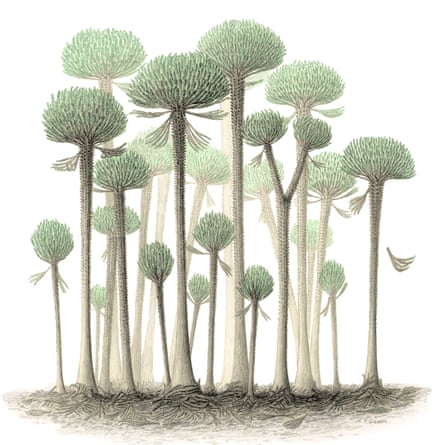The world’s oldest fossilised trees, dating back 390m years, have been found in the high sandstone cliffs along the Devon and Somerset coast.
The fossilised trees are the oldest ever found, roughly 4m years older than the previous record holder, which was found in New York state.
The fossilised trees, known as Calamophyton, would resemble palm trees if seen from a distance, but were a “prototype” of the kinds of tree we are familiar with today. Rather than solid wood, their trunks were thin and hollow in the centre and they stood between 2 and 4 metres tall. They also lacked leaves; their branches were covered in hundreds of twig-like structures.
The fossils were found near Minehead, on the south bank of the Bristol Channel, near what is now a Butlin’s holiday camp.
“This was a pretty weird forest – not like any forest you would see today,” said Prof Neil Davies, a geologist at the University of Cambridge and the study’s first author. “There wasn’t any undergrowth to speak of and grass hadn’t yet appeared, but there were lots of twigs dropped by these densely packed trees, which had a big effect on the landscape.”
Scientists had previously assumed that this stretch of the English coast did not contain significant plant fossils, but this find shows how early trees helped shape landscapes and stabilise riverbanks and coastlines hundreds of millions of years ago. The results are reported in the Journal of the Geological Society.

The forest dates back to the Devonian period, between 358m and 419m years ago, when life started its first big expansion on to land. By the end of the period, the first seed-bearing plants had appeared and the earliest land animals, mostly arthropods, were well established.
“The Devonian period fundamentally changed life on Earth,” said Davies. “It also changed how water and land interacted with each other, since trees and other plants helped stabilise sediment through their root systems, but little is known about the very earliest forests.”
The fossil forest identified by the researchers was found in the Hangman sandstone formation, along the north Devon and west Somerset coasts. During the Devonian period, this region was not attached to the rest of England, but instead lay farther south, connected to parts of Germany and Belgium, where similar Devonian fossils have been found.

“When I first saw pictures of the tree trunks, I immediately knew what they were, based on 30 years of studying this type of tree worldwide,” said Dr Christopher Berry, a palaeobotanist at Cardiff University and the study’s co-author. “It was amazing to see them so near to home. But the most revealing insight comes from seeing, for the first time, these trees in the positions where they grew.
“It is our first opportunity to look directly at the ecology of this earliest type of forest, to interpret the environment in which Calamophyton trees were growing, and to evaluate their impact on the sedimentary system.”
The fieldwork was undertaken along the highest sea cliffs in England, some of which are accessible only by boat, and revealed that this sandstone formation is in fact rich with plant fossil material from the Devonian period.
During that era, the site was a semi-arid plain, crisscrossed by small river channels spilling out from mountains to the north-west. The emergence of the first tightly packed clusters of trees would have affected the way that rivers flowed across the landscape, the researchers said. “People sometimes think that British rocks have been looked at enough, but this shows that revisiting them can yield important new discoveries,” said Davies.



